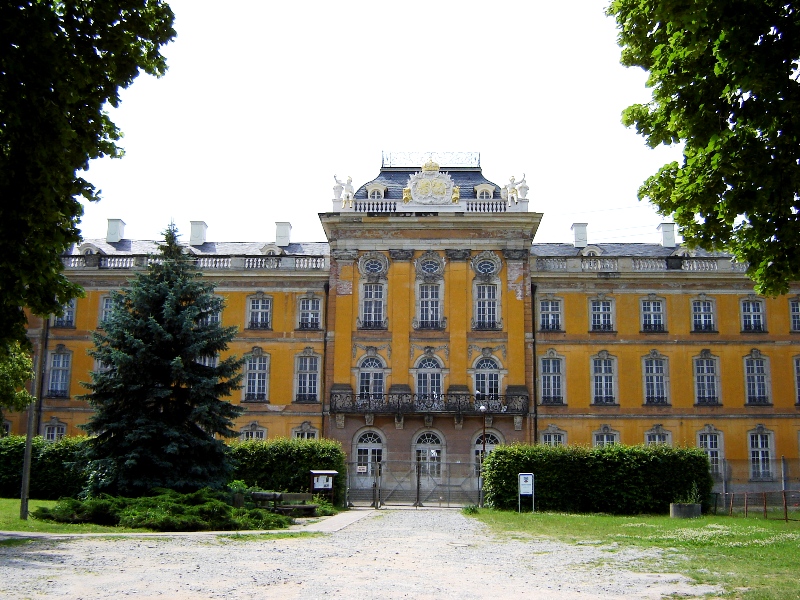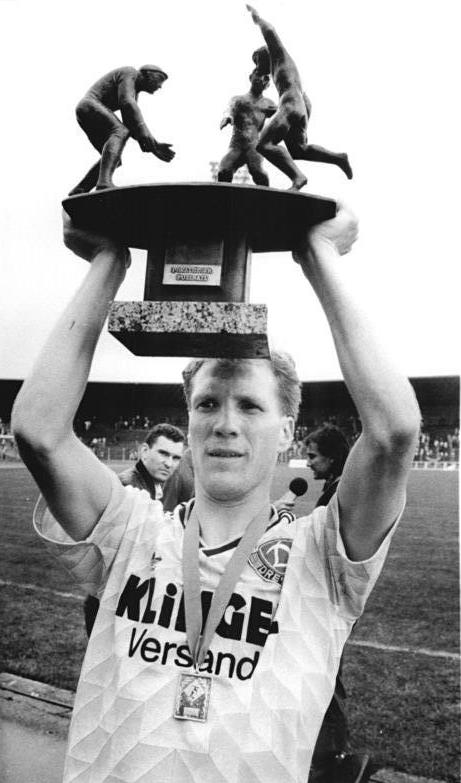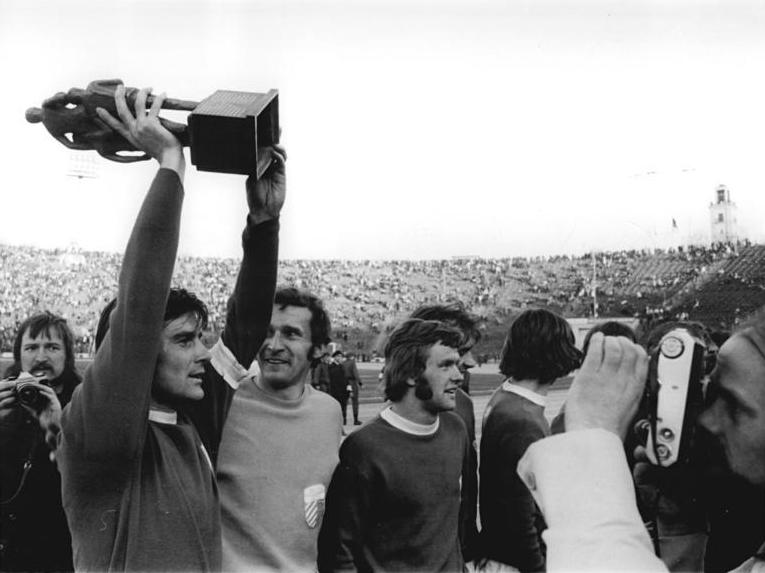|
Martin Hoffmann (footballer)
Martin Hoffmann (born 22 March 1955 in Gommern) is a former German footballer and manager. Career Playing career Hoffmann played from 1973 to 1985 for 1. FC Magdeburg in the East German top division, amassing 256 matches and scoring 78 goals. With Magdeburg, he won the league title in 1974 and 1975, and the cup title in 1978, 1979 and 1983. The biggest title of all is the European Cup Winners' Cup, as Magdeburg defeated AC Milan 2–0 on 8 May 1974 in Rotterdam. He also played for the East Germany national football team, making 62 appearances and scoring 15 goals between 1973 and 1981. In 1974, he played in six matches for East Germany in the 1974 FIFA World Cup, scoring once against Chile. In 1976, he was in the East German team which won the gold medal in the 1976 Summer Olympics in Montreal, playing in 5 matches and scoring once in the final against Poland. Coaching career He worked as manager of 1. FC Magdeburg in the twice, from 1994 to 1996 and from 2002 to 2003. I ... [...More Info...] [...Related Items...] OR: [Wikipedia] [Google] [Baidu] |
Gommern
Gommern () is a town in the Jerichower Land district, in Saxony-Anhalt, Germany. It is situated approximately southeast of Magdeburg. On January 1, 2005, the municipalities Dannigkow, Dornburg, Karith, Ladeburg, Leitzkau, Menz, Nedlitz, Vehlitz and Wahlitz have been incorporated into Gommern. On January 1, 2008, Prödel was incorporated, and on January 1, 2009, Lübs was incorporated. Local council Elections in October 2005: Elections in May 2014: Dornburg Charles, Prince of Anhalt-Zerbst, had a new castle built at Dornburg near Gommern from 1674, which he gave to his brother, John Louis I, Prince of Anhalt-Dornburg. It was inherited by the latter's second son, Christian August, Prince of Anhalt-Zerbst. In 1747 he died and the castle burnt down in 1750. His widow, Johanna Elisabeth of Holstein-Gottorp, governed the principality of Anhalt-Zerbst for her son Frederick Augustus until 1752. She had the new castle at Dornburg built as her thirds from 1750, a lavish baroque pa ... [...More Info...] [...Related Items...] OR: [Wikipedia] [Google] [Baidu] |
Mecklenburg
Mecklenburg (; nds, label=Low German, Mękel(n)borg ) is a historical region in northern Germany comprising the western and larger part of the federal-state Mecklenburg-Western Pomerania. The largest cities of the region are Rostock, Schwerin, Neubrandenburg, Wismar and Güstrow. The name Mecklenburg derives from a castle named '' Mikilenburg'' (Old Saxon for "big castle", hence its translation into New Latin and Greek as ), located between the cities of Schwerin and Wismar. In Slavic languages it was known as ''Veligrad'', which also means "big castle". It was the ancestral seat of the House of Mecklenburg; for a time the area was divided into Mecklenburg-Schwerin and Mecklenburg-Strelitz among the same dynasty. Linguistically Mecklenburgers retain and use many features of Low German vocabulary or phonology. The adjective for the region is ''Mecklenburgian'' or ''Mecklenburgish'' (german: mecklenburgisch, link=no); inhabitants are called Mecklenburgians or Mecklenburgers ( ... [...More Info...] [...Related Items...] OR: [Wikipedia] [Google] [Baidu] |
1955 Births
Events January * January 3 – José Ramón Guizado becomes president of Panama. * January 17 – , the first nuclear-powered submarine, puts to sea for the first time, from Groton, Connecticut. * January 18– 20 – Battle of Yijiangshan Islands: The Chinese Communist People's Liberation Army seizes the islands from the Republic of China (Taiwan). * January 22 – In the United States, The Pentagon announces a plan to develop intercontinental ballistic missiles (ICBMs), armed with nuclear weapons. * January 23 – The Sutton Coldfield rail crash kills 17, near Birmingham, England. * January 25 – The Presidium of the Supreme Soviet of the Soviet Union announces the end of the war between the USSR and Germany, which began during World War II in 1941. * January 28 – The United States Congress authorizes President Dwight D. Eisenhower to use force to protect Formosa from the People's Republic of China. February * February 10 – The United States Sev ... [...More Info...] [...Related Items...] OR: [Wikipedia] [Google] [Baidu] |
FDGB-Pokal 1982-83
The FDGB-Pokal (Freier Deutscher Gewerkschaftsbund Pokal or Free German Trade Union Federation Cup) was an elimination football tournament held annually in East Germany. It was the second most important national title in East German football after the DDR-Oberliga championship. The founder of the competition was East Germany's major trade union. History The inaugural FDGB-Pokal (generally referred to in English as the East German Cup) was contested in 1949, four years before the initial DFB-Pokal was played in the western half of the country. The first national cup competition had been the Tschammerpokal introduced in 1935. Each football club which participated in the East German football league system was entitled to enter the tournament. Clubs from the lower leagues played in regional qualification rounds, with the winners joining the teams of the DDR-Oberliga and DDR-Liga in the main round of the tournament of the following year. Each elimination was determined by a sing ... [...More Info...] [...Related Items...] OR: [Wikipedia] [Google] [Baidu] |
FDGB-Pokal 1978-79
The FDGB-Pokal (Freier Deutscher Gewerkschaftsbund Pokal or Free German Trade Union Federation Cup) was an elimination football tournament held annually in East Germany. It was the second most important national title in East German football after the DDR-Oberliga championship. The founder of the competition was East Germany's major trade union. History The inaugural FDGB-Pokal (generally referred to in English as the East German Cup) was contested in 1949, four years before the initial DFB-Pokal was played in the western half of the country. The first national cup competition had been the Tschammerpokal introduced in 1935. Each football club which participated in the East German football league system was entitled to enter the tournament. Clubs from the lower leagues played in regional qualification rounds, with the winners joining the teams of the DDR-Oberliga and DDR-Liga in the main round of the tournament of the following year. Each elimination was determined by a sing ... [...More Info...] [...Related Items...] OR: [Wikipedia] [Google] [Baidu] |
FDGB-Pokal 1977-78
The FDGB-Pokal (Freier Deutscher Gewerkschaftsbund Pokal or Free German Trade Union Federation Cup) was an elimination football tournament held annually in East Germany. It was the second most important national title in East German football after the DDR-Oberliga championship. The founder of the competition was East Germany's major trade union. History The inaugural FDGB-Pokal (generally referred to in English as the East German Cup) was contested in 1949, four years before the initial DFB-Pokal was played in the western half of the country. The first national cup competition had been the Tschammerpokal introduced in 1935. Each football club which participated in the East German football league system was entitled to enter the tournament. Clubs from the lower leagues played in regional qualification rounds, with the winners joining the teams of the DDR-Oberliga and DDR-Liga in the main round of the tournament of the following year. Each elimination was determined by a sing ... [...More Info...] [...Related Items...] OR: [Wikipedia] [Google] [Baidu] |
FDGB-Pokal
The FDGB-Pokal (Freier Deutscher Gewerkschaftsbund Pokal or Free German Trade Union Federation Cup) was an elimination football tournament held annually in East Germany. It was the second most important national title in East German football after the DDR-Oberliga championship. The founder of the competition was East Germany's major trade union. History The inaugural FDGB-Pokal (generally referred to in English as the East German Cup) was contested in 1949, four years before the initial DFB-Pokal was played in the western half of the country. The first national cup competition had been the Tschammerpokal introduced in 1935. Each football club which participated in the East German football league system was entitled to enter the tournament. Clubs from the lower leagues played in regional qualification rounds, with the winners joining the teams of the DDR-Oberliga and DDR-Liga in the main round of the tournament of the following year. Each elimination was determined by a sing ... [...More Info...] [...Related Items...] OR: [Wikipedia] [Google] [Baidu] |
DDR-Oberliga 1977-78
The DDR-Oberliga (English: ''East German Premier League'' or ''GDR Premier League'') was the top-level association football league in East Germany. Overview Following World War II, separate sports competitions emerged in the occupied eastern and western halves of Germany, replacing the ''Gauligas'' of the Nazi era. In East Germany, a top-flight football competition, the highest league in the East German football league system, was established in 1949 as the DS-Oberliga (''Deutscher Sportausschuss Oberliga'', German Sports Association Upper League). Beginning in 1958, it carried the name DDR-Oberliga and was part of the league structure within the DFV (''Deutscher Fussball-Verband der DDR'', German Football Association of the GDR). In its inaugural season in 1949/50, the DDR-Oberliga was made up of 14 teams with two relegation spots. Over the course of the next four seasons, the number of teams in the division varied and included anywhere from 17 to 19 sides with three or fo ... [...More Info...] [...Related Items...] OR: [Wikipedia] [Google] [Baidu] |
DDR-Oberliga 1976-77
The DDR-Oberliga (English: ''East German Premier League'' or ''GDR Premier League'') was the top-level association football league in East Germany. Overview Following World War II, separate sports competitions emerged in the occupied eastern and western halves of Germany, replacing the ''Gauligas'' of the Nazi era. In East Germany, a top-flight football competition, the highest league in the East German football league system, was established in 1949 as the DS-Oberliga (''Deutscher Sportausschuss Oberliga'', German Sports Association Upper League). Beginning in 1958, it carried the name DDR-Oberliga and was part of the league structure within the DFV (''Deutscher Fussball-Verband der DDR'', German Football Association of the GDR). In its inaugural season in 1949/50, the DDR-Oberliga was made up of 14 teams with two relegation spots. Over the course of the next four seasons, the number of teams in the division varied and included anywhere from 17 to 19 sides with three or fo ... [...More Info...] [...Related Items...] OR: [Wikipedia] [Google] [Baidu] |
DDR-Oberliga 1974-75
The DDR-Oberliga (English: ''East German Premier League'' or ''GDR Premier League'') was the top-level association football league in East Germany. Overview Following World War II, separate sports competitions emerged in the occupied eastern and western halves of Germany, replacing the ''Gauligas'' of the Nazi era. In East Germany, a top-flight football competition, the highest league in the East German football league system, was established in 1949 as the DS-Oberliga (''Deutscher Sportausschuss Oberliga'', German Sports Association Upper League). Beginning in 1958, it carried the name DDR-Oberliga and was part of the league structure within the DFV (''Deutscher Fussball-Verband der DDR'', German Football Association of the GDR). In its inaugural season in 1949/50, the DDR-Oberliga was made up of 14 teams with two relegation spots. Over the course of the next four seasons, the number of teams in the division varied and included anywhere from 17 to 19 sides with three or fo ... [...More Info...] [...Related Items...] OR: [Wikipedia] [Google] [Baidu] |
DDR-Oberliga 1973-74
The DDR-Oberliga (English: ''East German Premier League'' or ''GDR Premier League'') was the top-level association football league in East Germany. Overview Following World War II, separate sports competitions emerged in the occupied eastern and western halves of Germany, replacing the ''Gauligas'' of the Nazi era. In East Germany, a top-flight football competition, the highest league in the East German football league system, was established in 1949 as the DS-Oberliga (''Deutscher Sportausschuss Oberliga'', German Sports Association Upper League). Beginning in 1958, it carried the name DDR-Oberliga and was part of the league structure within the DFV (''Deutscher Fussball-Verband der DDR'', German Football Association of the GDR). In its inaugural season in 1949/50, the DDR-Oberliga was made up of 14 teams with two relegation spots. Over the course of the next four seasons, the number of teams in the division varied and included anywhere from 17 to 19 sides with three or fo ... [...More Info...] [...Related Items...] OR: [Wikipedia] [Google] [Baidu] |
DDR-Oberliga
The DDR-Oberliga (English: ''East German Premier League'' or ''GDR Premier League'') was the top-level association football league in East Germany. Overview Following World War II, separate sports competitions emerged in the occupied eastern and western halves of Germany, replacing the ''Gauligas'' of the Nazi era. In East Germany, a top-flight football competition, the highest league in the East German football league system, was established in 1949 as the DS-Oberliga (''Deutscher Sportausschuss Oberliga'', German Sports Association Upper League). Beginning in 1958, it carried the name DDR-Oberliga and was part of the league structure within the DFV (''Deutscher Fussball-Verband der DDR'', German Football Association of the GDR). In its inaugural season in 1949/50, the DDR-Oberliga was made up of 14 teams with two relegation spots. Over the course of the next four seasons, the number of teams in the division varied and included anywhere from 17 to 19 sides with three or fo ... [...More Info...] [...Related Items...] OR: [Wikipedia] [Google] [Baidu] |






